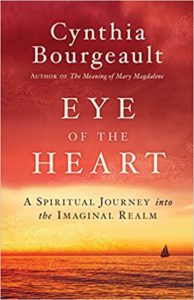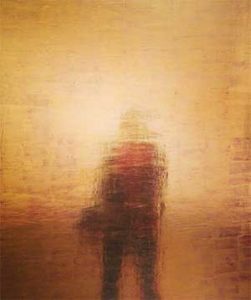The following review of Cynthia’s book Eye of the Heart: A Spiritual Journey into the Imaginal Realm is provided by David Lorimer from Paradigm Explorer, the journal of The Scientific and Medical Network, edition 2021/1
 Cynthia Bourgeault is a mystic (my dictation system insisted on mistake!), Episcopal priest, theologian and retreat leader who is one of the leading contemporary advocates of centring prayer and the rediscovery of the Wisdom and Mary Magdalene as wisdom teachers on the basis of the Gnostic Gospels. I reviewed her book on Mary Magdalene in December 2019. This new book is quite remarkable both as a personal spiritual odyssey and a profound journey into the neglected imaginal realm that can be perceived through the eye of the heart. The revival of Christian contemplation is essential to the spiritual renaissance of our time where unity and union is found only in the depths. This is mediated equally in intimate encounters and persistent spiritual practice.
Cynthia Bourgeault is a mystic (my dictation system insisted on mistake!), Episcopal priest, theologian and retreat leader who is one of the leading contemporary advocates of centring prayer and the rediscovery of the Wisdom and Mary Magdalene as wisdom teachers on the basis of the Gnostic Gospels. I reviewed her book on Mary Magdalene in December 2019. This new book is quite remarkable both as a personal spiritual odyssey and a profound journey into the neglected imaginal realm that can be perceived through the eye of the heart. The revival of Christian contemplation is essential to the spiritual renaissance of our time where unity and union is found only in the depths. This is mediated equally in intimate encounters and persistent spiritual practice.
It is particularly important to insist on the reality of subtle realms at a time when scientific materialism cuts us off from these dimensions by denying their very existence, which is equivalent to pulling up our spiritual roots, causing us to wither inwardly on the vine. Cynthia explains that energy rather than substance is the coin of this realm, as also affirmed by Valentin Tomberg, Teilhard de Chardin, Gurdjieff, Simone Weil and many others. We can then discern that there is a chain between the terms matter, energy, psyche, fire and spirit. A central implication is that the fruits of the spirit or virtues are energetically cultivated as counterentropic ‘psychic force’ through attention, will, prayer and love. This represents concentration rather than the dissipation of modern technological distractions. Once deeply embedded, these spiritual qualities are dynamically emanated and radiated by holy people in what Teilhard called radial energy. It is also important to note that this work is an individual responsibility that is equally vital for collective advancement – in his lifetime, Gurdjieff was already concerned by a drop in the overall level of being that can only be maintained through this inner work of what he called conscious labour and intentional suffering (cf ora et labora in the Benedictine tradition). This is also the function of contemplation and intercessory prayer from churches, mosques, temples and monasteries.
It is particularly important to insist on the reality of subtle realms at a time when scientific materialism cuts us off from these dimensions by denying their very existence, which is equivalent to pulling up our spiritual roots, causing us to wither inwardly on the vine.
Cynthia explains that we live in a mixed realm – mixtus orbis – where the invisible or imaginal interpenetrate the physical in a process of energy exchange, as TS Eliot eloquently articulates in his Four Quartets. She gives us a map of these levels of consciousness or spheres of causality that can also be tabulated in musical form. World 1 is the absolute, becoming World 3 as the primordial ternary is manifest in perceptivity and divisibility. World 6 is causal or logoic, the substance of which is Love; then World 12 is Christic embodied love or bodhisattva consciousness where eros is transfigured into agape. World 24 represents presence or the Kingdom of Heaven, while World 48 is the familiar physical world. World 96 is dense and conditioned where personality obscures essence, densifying further into World 192, the hell realms.
The role of the conscious human being is to translate and transmit energies mainly from World 24 into World 48, though we have the capacity to reach into the finer realms as well. There is an extraordinarily illuminating diagram on page 49 that contrasts the governing principles of Worlds 24 and 48 that is worth reproducing in full:
| World 48 | World 24 |
| linear time | radial/spatial time |
| sequential causality | synchronous causality |
| either-or dualism | non-duality |
| corporeal density | fluid and permeable boundaries |
| nucleated selfhood | holographic selfhood |
| attraction/aversion | conscience |
| entropic | counter-entropic |
| tangential energy | radial, generative energy |
| flesh & blood and body | subtle inner body |
| virtue as descriptor | virtue as operative energy |
Teilhard grasped this point in the 1920s when he spoke about le milieu divin where faith changes ‘the subtle physical composition of materiality’ in an alchemical process through radial energetic impact – this is the work of the surrendered will, conscious attention, presence and transformation. Inwardly and at a subtle level we are citizens of World 24 but we live in the coarser realm of the physical, whose role is to generate the necessary tension, density, resistance and entropy. Readers can see how World 24 embodies the spiritual aspirations of inhabitants of World 48, which Jung translates into synchronicity – the impinging or interpenetration of 24 on 48.
Cynthia sums this up by saying that ‘the way we can really show up for cosmic service boils down to learning to live in World 48 under the laws of World 24’ (p. 65) where we can take our cue from synchronicities as manifestations of imaginal causality that reveal a hidden pattern. She goes on to explain this with a spatial concentric metaphor also applied to sacred texts such as the Gospel of John. What she calls the art of shapeshifting can be learned through symbolism, correspondence, convergent timing and centring contemplation, all of which involve a subtle operating system that expands our perceptual bandwidth by opening the eye of the heart, which in turn makes us more receptive; interestingly, the word obedience derives etymologically from ob-audire – to listen from the depths.
 Returning to the mixtus orbis, we find ourselves as humans ‘at the intersection of the timeless and time’ (Eliot), of divine and human, of infinite and finite, all of which provides the raw material for conscious transfiguration as Love draws us back to the epicentre through a fully awakened and surrendered human heart where ‘imaginal transformation requires a transcendence of the narrative or phenomenal self as the seat of my selfhood… and a stabilisation of the witnessing self’ – in other words, living in 48 from 24, which is perhaps what Jesus meant when he said we should be in the world but not of it. Through this practice, we join the conscious circle of humanity, as her teacher and companion Brother Rafe put it – he plays a central role in the personal narrative, even though he passed over in 1995, but it is as if her journey and his continue in the same footsteps (p. 168), with close resonances with the teachings of Thomas Keating and Joseph Boyle representing the higher intellectual centre and the pure heart respectively. There is also the ongoing work of purification, what she calls cosmic dialysis so as to allow a greater purity of transmission.
Returning to the mixtus orbis, we find ourselves as humans ‘at the intersection of the timeless and time’ (Eliot), of divine and human, of infinite and finite, all of which provides the raw material for conscious transfiguration as Love draws us back to the epicentre through a fully awakened and surrendered human heart where ‘imaginal transformation requires a transcendence of the narrative or phenomenal self as the seat of my selfhood… and a stabilisation of the witnessing self’ – in other words, living in 48 from 24, which is perhaps what Jesus meant when he said we should be in the world but not of it. Through this practice, we join the conscious circle of humanity, as her teacher and companion Brother Rafe put it – he plays a central role in the personal narrative, even though he passed over in 1995, but it is as if her journey and his continue in the same footsteps (p. 168), with close resonances with the teachings of Thomas Keating and Joseph Boyle representing the higher intellectual centre and the pure heart respectively. There is also the ongoing work of purification, what she calls cosmic dialysis so as to allow a greater purity of transmission.
All this inner work serves to create the substance of a subtle light body which has a finer order of substantiality building what she calls a temporary permanent individuality that invites a deeper level of dying, so beautifully expressed in a passage quoted from Huston Smith about successive layers of dissolution that also invite absorption in the beatific vision and final freedom from personality. So there is both a building up and a peeling away in the knowledge that we die into love. My review of this seminal spiritual text for our time would be incomplete without mentioning Cynthia’s turbulent adventure with wild sailor Johnny the Greek as a demonstration of how she deftly weaves lessons from her life experience into this courageous and pioneering narrative. The book is nothing less than a manual for this alchemical energetic work of conscious transformation on which the very future of the planet depends.
This book review is shared with permission from David Lorimer and Paradigm Explorer.
Paradigm Explorer is a member journal published by The Scientific and Medical Network to provide articles, ideas, and book reviews that explore the interface between science, consciousness, and spirituality. Find out more here.
